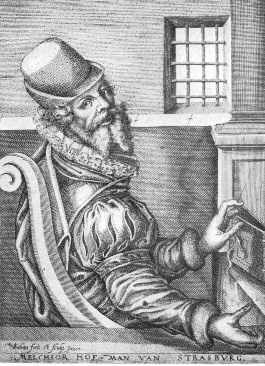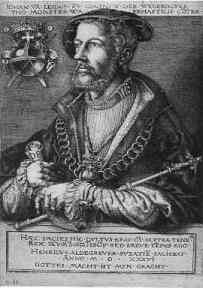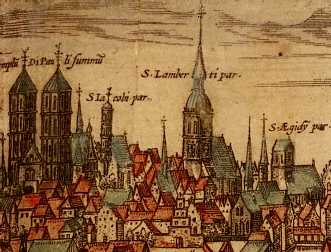

An itinerant lay preacher was Melchior Hoffmann,  a furrier/merchant from southern Germany turned evangelist. He was initially a follower of Luther, but his views were far more radical, and they soon had a falling out. After bouncing around the Baltic causing trouble, he eventually wound up in the late 1520s in Strasburg, a city that a center of reforming thought. Hoffmann added to his radical beliefs (including the rejection of infant baptism) a millenarian eschatology that was based in part on medieval delusions along these lines and was strongly influenced by the crazy but appealing imagery of the Book of Apocalype (Revelation). Among other things, Hoffmann believed the end of the world was at hand and subscribed to the visions supposedly seen by some of his low-class followers. Hoffmann thought that Strasburg would be the site of the "New Jerusalem" whose establishment prophesied in Apocalypse after the defeat of the godless. The town fathers of Strasburg did not, however, appreciate the future glory that Hoffmann had in store for them, and they had him arrested in 1533. He remained imprisoned until his death in 1543. (For what it's worth, this resolution of the problem he posed to peace in Strasburg is in stark contrast with the treatment he could have expected from Catholic authorities, who would undoubtedly have had him burned alive.)
a furrier/merchant from southern Germany turned evangelist. He was initially a follower of Luther, but his views were far more radical, and they soon had a falling out. After bouncing around the Baltic causing trouble, he eventually wound up in the late 1520s in Strasburg, a city that a center of reforming thought. Hoffmann added to his radical beliefs (including the rejection of infant baptism) a millenarian eschatology that was based in part on medieval delusions along these lines and was strongly influenced by the crazy but appealing imagery of the Book of Apocalype (Revelation). Among other things, Hoffmann believed the end of the world was at hand and subscribed to the visions supposedly seen by some of his low-class followers. Hoffmann thought that Strasburg would be the site of the "New Jerusalem" whose establishment prophesied in Apocalypse after the defeat of the godless. The town fathers of Strasburg did not, however, appreciate the future glory that Hoffmann had in store for them, and they had him arrested in 1533. He remained imprisoned until his death in 1543. (For what it's worth, this resolution of the problem he posed to peace in Strasburg is in stark contrast with the treatment he could have expected from Catholic authorities, who would undoubtedly have had him burned alive.)
Before his arrest, Hoffmann was by no means idle, and actively proselytized his beliefs in the Low Countries (more or less modern Holland and Belgium), Frisia and the Emland (territories along the North Sea coast of present-day Holland and Germany). His millenarian and messianic views were readily accepted by the "sacramentarians" of the Low Countries, and the region was in the grip of the expectation that the Apocalypse would engulf the world by the end of 1533. By now, Hoffmann was under arrest in Strasburg, and when the authorities had executed some of his followers at the end of 1531, he ordered (on Apocalyptic authority) a two-year prohibition on adult baptism until 1533.
But by late 1533 his enthusiastic followers were chafing at the bit, and leadership of the movement was taken over by the Dutch baker John Matthison (Matthys), who authorized the resumption of baptism. Hoffmann had always seen himself and another follower as the prophets Elijah and Enoch foretold in Apocalypse 11, but while Hoffmann was still given the lead role by his followers, Matthison now assumed the role of Enoch. The prophet now sent out "apostoles" to spread the good word, and it is at this point that the radical Anabaptists come into the story of the city of Münster.
Münster was the metropolis of Westphalia, and the city was ruled by its bishop, who was supposedly subordinate to the Holy Roman Empire. In practice, however, the bishop is known as a "prince-bishop" in recognition of his secular authority. The city was itself governed by a city council of wealthy burghers, who had over the years acquired various rights ("liberties") from the prince-bishops. As was often the case in the 1520s, the city council found the independence from ecclesiastical authority that was implicit in Luther's Reformation appealing, and there had been wrangling with the prince-bishop for some time over the city's right to employ non-Catholic preachers in the city's parishes. Prominent among these reforming clergyman was Bernard Rothmann. There were prolonged disputes about his views in particular in the early 1530s, when the bishopric experienced a quick turn-over in incumbents. In late 1533, the disputes with the new prince-bishop, Fredrick of Waldeck, resulted in a sort of civil war, at the end of which the prince-bishop was forced to grant to the city what amounted to self-government. It was in this delicate situation that the beliefs propagated by Hoffmann and Matthison began to play an important role.
Radical ideas  had already entered the city, and Rothmann fell under their influence. In early 1534, apostles dispatched by Matthison reached the city and converted Rothmann and others, including the city councilor Bernard Knipperdolling (no, really!). Matthison himself eventually showed up, and the municipal elections of March, the Anabaptists took control of the city government. Soon the traditional form of government was replaced with rule by Biblically inspired "Elders." All this was too much for the prince-bishop, who resolved to raise a military force and seize the city by force. In April, Matthison fell in battle, and leadership fell to his fellow Dutchman, the tailor John Bockelson of Leiden. A major assault on the city by the besieging forces was repelled by the Anabaptists, and in the glow of victory, John was crowned king. Apart from government by divine revelation, the Anabaptists introduced a form of communal property holding based on the supposed joint ownership of property by the apostles as laid out in the Book of Acts.
had already entered the city, and Rothmann fell under their influence. In early 1534, apostles dispatched by Matthison reached the city and converted Rothmann and others, including the city councilor Bernard Knipperdolling (no, really!). Matthison himself eventually showed up, and the municipal elections of March, the Anabaptists took control of the city government. Soon the traditional form of government was replaced with rule by Biblically inspired "Elders." All this was too much for the prince-bishop, who resolved to raise a military force and seize the city by force. In April, Matthison fell in battle, and leadership fell to his fellow Dutchman, the tailor John Bockelson of Leiden. A major assault on the city by the besieging forces was repelled by the Anabaptists, and in the glow of victory, John was crowned king. Apart from government by divine revelation, the Anabaptists introduced a form of communal property holding based on the supposed joint ownership of property by the apostles as laid out in the Book of Acts.
Needless to say, the prince-bishop was none too happy with this turn of events, but he was running out of money to fund his expensive campaign and was forced to seek support from neighboring princes (who to some extent took over control of the besieging army). The siege was tightened, and the situation began to deteriorate in the city. Eventually, two refugees from the city surrendered to the besiegers and suggested a way into the city. Through some sort of inexplicable inepitude, a small force managed to penetrate the city' heavy defenses without any trouble, and after a certain amount of to-do, they opened the city to the besiegers, who captured it for the prince-bishop. After being exhibited around in a sort of freak show for some months, John of Leiden, Knipperdoling and one other luminary of the Anabaptist regime were tortured to death in 1536. Their bodies were then exposed in iron cages that can still be seen in the city today.
 Hermann of Kerssenbrock was the Catholic schoolmaster of the local grammar school. He composed a monumental history of the Anabaptist events known as the "Narrative of the Anabaptist Madness" (Anabaptistici furoris ennaratio). This was in part based on his own recollections of the events in his teens. He also used previous written sources, as well as his access to the prince-bishops archives. By 1573, he was ready to publish the work, but soon became embroiled in a prolonged and incredibly tedious dispute with the city council, which took exception to his account. One of the reasons was that he supposedly revealed too much about the city's defenses, but the real reason seems to be that certain material in the book was interpreted by the city council as taking the bishop's side in various ongoing disutes between the council and the bishop. Also, certain important people took exception to his portrayal of their ancestors behavior. The upshot was that to get out of the dispute, Kerssenbrock never published the work, which circulated for centuries in manuscript format and had a great influence on the historiography of the events in Münster. An inept translation into German was made in 1771, and the Latin text was finally published by H. Detmar in 1899-1900.
Hermann of Kerssenbrock was the Catholic schoolmaster of the local grammar school. He composed a monumental history of the Anabaptist events known as the "Narrative of the Anabaptist Madness" (Anabaptistici furoris ennaratio). This was in part based on his own recollections of the events in his teens. He also used previous written sources, as well as his access to the prince-bishops archives. By 1573, he was ready to publish the work, but soon became embroiled in a prolonged and incredibly tedious dispute with the city council, which took exception to his account. One of the reasons was that he supposedly revealed too much about the city's defenses, but the real reason seems to be that certain material in the book was interpreted by the city council as taking the bishop's side in various ongoing disutes between the council and the bishop. Also, certain important people took exception to his portrayal of their ancestors behavior. The upshot was that to get out of the dispute, Kerssenbrock never published the work, which circulated for centuries in manuscript format and had a great influence on the historiography of the events in Münster. An inept translation into German was made in 1771, and the Latin text was finally published by H. Detmar in 1899-1900.
My translation is based on Detmar's edition, and will for the first time make this influencial work available to those who don't want to wade through 945 pages of Classicizing Latin (even if they have access to the original).
Kerssenbrock is certainly no historiographical genius. He makes numerous blunders of chronology, and he is not even aware of the important part played in the events of 1524-1535 by the "Melchorite" followers of Matthison (he seems not even to know of Hoffmann's existence). Nonetheless, the work is important in a number of regards. First, it is interesting in its own right as the interpretation of a rather idiosyncratic Catholic from the time of the Counter Reformation. Second, Kerssenbrock preserves a number of documents not otherwise extant. Third, even those who disparage his influence on later historiography would do well to have direct familiarity with the work that did so much to shape earlier views on the subject. Fourth, the work has an intrisic interest as an early modern attempt at history-writing. Though one does at times get weary of Kerssenbrock's seemingly indefatigable zeal in translating one tiresome piece of coresondence after another into indirect discourse in Latin, it is also a pleasure to see how he adapts the administrative and political terminology of the Late Roman Republic and the Empire to describe the institutions of the late medieval/early modern prince-bishopric of Münster.
The translation is now available.
Update as of August 2007. I recently received jpgs of a manuscript of Gresbeck's account that is in the collection of the Historisches Archiv of Cologne. The text is clearly more authentic than the one used by Cornelius for his edition of 1853 (his text is much more "High German" than the Cologne MS. I've started the laborious task of transcribing the Low German, and hope to have it done in a year or so. Then I can publish the revised translation with the superior Low German text.
Sometimes I wonder why I take such troubles over these projects. I have to grant that the number of people who will be interested in them can probably be counted on two hands. I remember once a long time ago hearing the head of SSHRC (the Social Sciences and Humanities Research Council of Canada) saying at a meeting that those whom the organization considers to be the bottom feeders engage in what they contemptuously refer to as "capricious research." I'm afraid I have to plead guilty to that characterization, and maybe that's why they don't think that the sort of research I do is worthy of funding. Myself, I think that making the most important contemporary sources about an important event in history accessible to a wider audience than one that can read 945 pages of Classicizing Latin used to describe the institutions of the medieval bishopric of Müster and Early Modern Low German is worthwhile. Then again, it's not my money. Not that I'm bitter or anything...